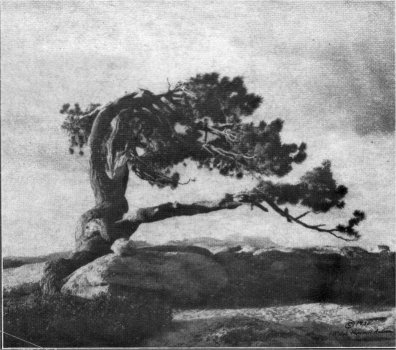THE CONE-BEARING
TREES of YOSEMITE

[click to enlarge] |
Special Number
YOSEMITE NATURE NOTES
May, 1939
Price 25 cents
| Online Library: | Title | Author | California | Geology | History | Indians | Muir | Mountaineering | Nature | Management |
Yosemite > Library > Cone-bearing Trees > The Cone-bearing Trees of Yosemite >
|
THE CONE-BEARING
| |
| |
|
Special Number
|
THE PUBLICATION OF
THE YOSEMITE NATURALIST DEPARTMENT
AND THE YOSEMITE NATURAL HISTORY ASSOCIATION
Published Monthly
| VOL. XVIII | MAY 1939 | No. 5 |
By James E. Cole, Junior Park Naturalist
The coniferous trees of California are known to surpass all others of their kind in extent, in size, and in the richness of species. Yosemite National Park comprises but a minute part of the area of California, yet, there grow within the park seventeen, or forty per cent, of the forty-three cone-bearing trees found in the State. This abundance of species in Yosemite is due principally to the many kinds of climates encountered in rising from elevations of 2000 feet at the western boundary to 13,000 feet at the summits of the Sierra along the eastern boundary. Then, too, the presence of deep canyons, broad valleys, mountain meadows, lake shores, stream banks, cliffs, domes, ridges and peaks all afford different growing conditions sufficiently varied for the diverse needs of this assemblage of trees
Visitors to Yosemite will enjoy their vacations more if they know the trees. Training in forestry is not necessary, for each of the seventeen conifers has singular characters that proclaim its identity to all who care to know. Learn those about your camp first. They are, in all probability, Western Yellow Pines, or Incense Cedars. Next, look for the White and Douglas Firs since both are quite common in Yosemite Valley. When these four conifers are identified, drive to Glacier Point and discover four more as you pass through the forests of Sugar Pines, Jeffrey Pines, Lodgepole Pines and Red Firs Only the persistent will find all seventeen of the cone-bearing trees of the park as three of them grow in restricted areas. The high mountain species require a trip by car, or better by foot, to their haunts. But the reward is worth the effort. It will give zest and direction to your vacation and you will sing with John Muir:
“Climb the mountains and get their good tidings.
Nature’s peace will flow into you as sunshine flows into trees.
The winds will blow their own freshness into you and the storms their energy
While cares will drop off like autumn leaves.”
* * *
Common and scientific names with the exception of Sequoia gigantea are taken from “Forest Trees of the Pacific Slope” by G. B. Sudworth, which has been designated by the National Park Service as the official tree check list.
| Online Library: | Title | Author | California | Geology | History | Indians | Muir | Mountaineering | Nature | Management |
http://www.yosemite.ca.us/library/cone-bearing_trees/introduction.html